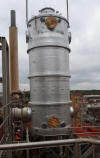|
||
| Sulphuric Acid on the WebTM | Technical Manual | DKL Engineering, Inc. |
Knowledge for the
Sulphuric Acid Industry
![]()
Sulphuric Acid on the Web
Introduction
General
Equipment Suppliers
Contractor
Instrumentation
Industry News
Maintenance
Acid
Traders
Organizations
Fabricators
Conferences
Used
Plants
Intellectual
Propoerty
Acid
Plant Database
Market
Information
Library
Technical Manual
Introduction
General
Definitions
Instrumentation
Plant Safety
Metallurgial
Processes
Metallurgical
Sulphur Burning
Acid Regeneration
Lead Chamber
Technology
Gas Cleaning
Contact
Strong Acid
Acid Storage
Loading/Unloading
Transportation
Sulphur
Systems
Liquid SO2
Boiler Feed Water
Steam Systems
Cooling Water
Effluent Treatment
Utilities
Construction
Maintenance
Inspection
Analytical Procedures
Materials of Construction
Corrosion
Properties
Vendor Data
DKL Engineering, Inc.
Handbook of Sulphuric Acid Manufacturing
Order
Form
Preface
Contents
Feedback
Sulphuric Acid
Decolourization
Order Form
Preface
Table of Contents
Process Engineering Data Sheets - PEDS
Order
Form
Table of Contents
Introduction
Bibliography of Sulphuric Acid Technology
Order Form
Preface
Contents
Acid Plant Database September 11, 2020
| Owner | Nyrstar |
|
| Location | Hoofdstraat 1 6024 AA Budel-Dorplein The Netherlands |
|
| Background |
Formerly - Budel Zink 1995 - Becomes a wholly owned subsidiary of Pasminco - Zinifex Budel Zink 2007 - Nystar announced that as of 31 August 2007 it had taken ownership of the zinc and lead smelting and alloying assests of Umicore and Zinifex, thereby formally launching the company and creating the world’s largest zinc producer. |
|
| Website | www.nyrstar.com | |
| Plant | Budel Plant | |
| Coordinates* | 51º 14' 15" N, 5º 36' 8" E | |
| Type of Plant | Metallurgical | |
| Gas Source |
Zinc Lurgi Fluid Bed Roaster |
|
| Plant Capacity | 1171 MTPD | |
| SA/DA |
Original: 2/2 DA Current: 3/2 DA - new single bed converter added in front of existing converter |
|
| Emissions | SO2: 200 mg/Nm3 | |
| Status | Operating | |
| Year Built | 1970's | |
| Technology | - | |
| Contractor | - | |
| Remarks | 1999
- October - Commissioning of plant
incorporating NOx removal SCR 2020 - 4 New WESP's installed |
|
| Pictures |   
 |
|
| General | The
Budel zinc smelter is situated on a 200 hectare site at Budel Dorplein in
the southeast of The Netherlands near the Belgian border and close to the
majority of its customers in the major industrial centres of The
Netherlands, Belgium, Germany, Luxembourg and northern France. Budel also
owns approximately 550 hectares of adjacent land. The current electrolytic
plant was commissioned in 1973, replacing the thermal zinc recovery
operation that had existed on the site since 1892. The smelter uses RLE
technology. The expansion of the plant was completed in 2006.
The Budel smelter is situated near Weert in the south east of the
Netherlands, near the Belgian border and close to major European industrial
centres in The Netherlands, Belgium, Germany, Luxemburg and northern France.
Approximately 80% of total product sales are delivered to customers within
300 kilometres of the plant.
The smelter was commissioned in 1973, uses conventional RLE
technology and is one of Europe's most efficient zinc smelters in terms of
its metallurgical performance. It produced
approximately 212,000 tonnes of zinc in 2003, however, after the planned
expansion to 232,000 tonnes per year scheduled for 2004, it will be about
the ninth largest zinc smelter in the world. |
|
| References | Van
Driel, J., Giesen, B., Berryman, A., Sampat, S., Enevoldsen, S. and
Jensen-Holm, H. |
|
| News | 2019
- Trafigura Group Pte Ltd., a market leader in the global commodities
industry, recently became the majority owner of the operating business of
Nyrstar, a global multi-metals business. “The closure of this capital
restructuring is excellent news for both Trafigura and Nyrstar,” said Jeremy
Weir, executive chairman and chief executive officer of Trafigura. “Nyrstar
is a significant global business that has been built on strong foundations.
The macro economic environment is positive for zinc concentrate and refined
zinc metal markets on a forward looking basis, and Nyrstar will be very
complementary to our existing trading activities. As an independently
operated company within the Group and with its restructured and strengthened
balance sheet, there is now the opportunity for Nyrstar to realise its full
potential.” Daniel Vanin has been appointed Chief Executive Officer of
the operating business of Nyrstar. With 40 years in the industry, he brings
extensive international mine and smelting development experience, alongside
strong management skills to the role. “I’ve already visited almost
every Nyrstar operation around the world. I’ve been impressed by the
fundamental strength of the assets, by the depth of technical knowledge of
the teams and by their passion for the work that they do. I’ve seen
many opportunities and solutions that could be implemented quickly. We will
also be able to draw on Trafigura’s technical, economic, and other
commercial expertise,” said Vanin. Over the next few months, a new
headquarters will be established at Nyrstar’s operations at Budel, in the
Netherlands. Members of Zurich-based staff whose roles are affected
have already been informed of these plans, with the employee consultation
process having taken place during July. |
|
MTPD - Metric Tonne per Day
STPD - Short Ton per Day
MTPA - Metric Tonne per Annum STPA - Short Ton per
Annum
SA - Single Absorption
DA - Double Absorption
* Coordinates can be used to
locate plant on Google Earth